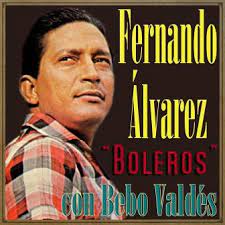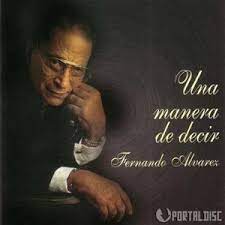FERNANDO ÁLVAREZ, UN CANTANTE QUE RESUMIÓ ARTISTICAMENTE UNA ETAPA DEL CANCIONERO CUBANO. PHOTOS/VIDEOS
Fernando Álvarez nacido en Santiago de Cuba el 4 de noviembre de 1927 fue un cantante cubano y uno de los intérpretes más destacados de la canción de los años 1950s y 1960s. Su voz popularizó y diseminó muchas de las mejores composiciones de la música popular y su carrera artística refleja un período entero en la historia de canciones cubanas.
Una voz cálida hasta el asombro, una dicción impecable, afinación extrema, estilo exclusivo, presencia y un atractivo que lo distinguió entre los intérpretes de la época, son las cualidades que hicieron al artista que hoy homenajeamos, uno de los grandes exponentes de la música cubana y uno de los boleristas más importantes en la extensa lista de boleristas de Latinoamérica.
 VIDEOS- Fernando Alvarez canta “Llanto de Luna”.
VIDEOS- Fernando Alvarez canta “Llanto de Luna”.
CARRERA ARTISTICA
En 1945 comenzó su carrera artística como vocalista en la Orquesta Hermanos Giro, dirigida por Sergio Calzado. Actuó en programas de la radio local; hizo presentaciones junto a Pacho Alonso y los Hermanos Bravo; trabajó en las Orquestas Armonía Tropical, Trovadores de Rancho Club y la de Reinaldo Dambay; en la jazz band del saxofonista santiaguero Pacho Portuondo y en la banda de Mariano Mercerón.
En los primeros años de la década de 1950 se trasladó a La Habana para integrarse a la big band de Benny Moré, quien le había prometido llevarlo a la capital en cuanto creara una banda propia. El propio Fernando rememoraba que Benny lo sacó de una ciudad de provincias, fue a casa de sus padres y se comprometió con ellos a no dejarlo solo hasta que lograra el éxito y cumplió su promesa.
Con la Orquesta del Benny, en la que hacía coro, se acompañaba con las maracas y en ocasiones cantaba una parte del repertorio bolerístico, permaneció hasta finales de 1955.
Posteriormente pasó a formar parte del Conjunto Casino dirigido por Roberto Espí, donde creció su popularidad y realizó creaciones interpretativas de diversas obras musicales, entre ellas los boleros “Humo y Espumas” y “Cada noche que pasa”, del compositor Rolando Rabí; “Llanto de luna”, de Julio Gutiérrez; “Canción de amor”, de Rolando Baró; “Llegaste tarde”, de Wello Rivas y “Si no eres tú”, de Pedro Flores.
 VIDEOS- Fernando Alvarez canta “Vida”..
VIDEOS- Fernando Alvarez canta “Vida”..
A partir de ese momento se convirtió en solista vocalista y fue contratado por el sello discográfico Gema, firma en la que grabó la canción “Ven aquí a la realidad”, de Ernesto Duarte, que constituyó un acontecimiento nacional e internacional, y que, a la vez, lo convirtió en una de las voces más aplaudidas de Cuba.
FERNANDO ALVAREZ EN LOS ESCENARIOS MUNDIALES
Realizó programas televisivos y radiofónicos y se presentó en centros nocturnos e importantes teatros del país. Compartió el escenario con destacados intérpretes como Pedro Vargas, Libertad Lamarque, Boby Capó, y efectuó numerosas actuaciones y giras por toda Hispanoamérica y Estados Unidos, país en el que obtuvo un éxito rotundo.
Su trayectoria como cantante se hizo notoria por su calidad técnico-artística e interpretativa, su selecto repertorio y por la recreación de obras como ‘Dos gardenias’, de Isolina Carrillo y ‘Cuando no te veo vida mía’, de Frank Domínguez, además de otras composiciones musicales de José Antonio Méndez, Tania Castellanos e Ignacio Villa.
Hizo incursiones también en el campo creativo con obras como el bolero “¡Ay tristeza!”.
Grabó discos de larga duración como ‘Otra vez con Fernando’, ‘Nueva vida’, ‘Refúgiate en mí’; y los CD, ‘Una manera de decir’ y ‘Sé feliz’. Este último es un compendio de boleros de la inspiración del destacado músico joven Descemer Bueno, que devino álbum memorable no sólo por constituir la última grabación que realizara en vida Fernando Álvarez, sino por confirmar su calidad como intérprete, no obstante los muchos años de ejecutoria musical. Este disco puso de manifiesto que, para emprender un proyecto con resultados encomiables, lo que cuenta es el talento y no si sus protagonistas pertenecen a generaciones diferentes.
En relación con esta producción el poeta Sigfredo Ariel ha escrito que la letra de la canción “Sé feliz” parece rara pero familiar, con una escritura sencilla, sin rebuscamientos intelectuales, que se ve reforzada por la magnífica interpretación de Fernando.
Fernando Álvarez fue una de las voces que conocieron e hicieron populares muchas de las más significativas composiciones de la creación musical popular, y de los cantantes cubanos que pueden resumir, en su carrera artística, una etapa de la historia de la cancionística cubana.
Falleció en La Habana, el 22 de agosto de 2002.
FERNANDO ÁLVAREZ, A SINGER WHO ARTISTICALLY SUMMED UP A PLACE OF THE CUBAN HISTORY’S SONGBOOK. PHOTOS/VIDEO
Fernando Álvarez born in Santiago de Cuba on November 4, 1927, was a Cuban singer and one of the most outstanding interpreters of the song of the 1950s and 1960s. His voice popularized and disseminated many of the best compositions of popular music and his artistic career reflects an entire period in the history of Cuban songs.
A voice warm to amazement, impeccable diction, extreme tuning, exclusive style, presence, and attractiveness that distinguished him among the performers of the time, are the qualities that made the artist we honor today one of the great exponents of music. Cuban and one of the most important boleristas in the extensive list of boleristas in Latin America.
 VIDEOS- Fernando Alvarez sings…
VIDEOS- Fernando Alvarez sings…
ARTISTIC CAREER
In 1945 he began his artistic career as a vocalist in the Orquesta Hermanos Giro, conducted by Sergio Calzado. He performed on local radio shows; he made presentations with Pacho Alonso and the Bravo Brothers; he worked in the Harmonía Tropical, Trovadores de Rancho Club, and Reinaldo Dambay orchestras; in the jazz band of saxophonist Pacho Portuondo from Santiago and in Mariano Mercerón’s band.
In the early 1950s, he moved to Havana to join Benny Moré’s big band, who had promised to take him to the capital as soon as he created his own band. Fernando himself recalled that Benny took him out of a provincial city, went to his parent’s house, and promised them not to leave him alone until he achieved success and fulfilled his promise.
With the Orquesta del Benny, in which he was a choir, he accompanied himself with the maracas and sometimes sang a part of the bolero repertoire, he remained until the end of 1955.
Later he became part of the Conjunto Casino directed by Roberto Espí, where his popularity grew and he made interpretive creations of various musical works, among them the boleros “Humo y Espumas” and “Cada Noche Que pasa”, by the composer Rolando Rabbi; “Llanto de luna”, by Julio Gutiérrez; “Song of love”, by Rolando Baró; “You arrived late”, by Wello Rivas and “If it’s not you”, by Pedro Flores.
From that moment on, he became a solo vocalist and was hired by the Gema record label, a company in which he recorded the song “Come here to reality”, by Ernesto Duarte, which constituted a national and international event, and which, At the same time, it made him one of the most applauded voices in Cuba.
FERNANDO ALVAREZ ON THE WORLD STAGES
He made television and radio programs and appeared in nightclubs and important theaters in the country. He shared the stage with outstanding performers such as Pedro Vargas, Libertad Lamarque, Boby Capó, and made numerous performances and tours throughout Latin America and the United States, a country in which he achieved resounding success.
Her career as a singer became notorious for her technical-artistic and interpretative quality, her select repertoire, and for the recreation of works such as ‘Dos gardenias’, by Isolina Carrillo and ‘When I don’t see you my love’, in addition to other musical compositions by José Antonio Méndez, Tania Castellanos and Ignacio Villa.
He also made inroads in the creative field with works such as the bolero “¡Ay triste!”.
He recorded long-playing albums such as ‘Otra vez con Fernando’, ‘Nueva Vida, ‘Refúgiate en mí’; and the CDs, ‘A way of saying’ and ‘Be happy’. The latter is a compendium of boleros inspired by the outstanding young musician Descemer Bueno, which became a memorable album not only for being the last recording made by Fernando Álvarez in his lifetime but also for confirming his quality as a performer, despite the many years of experience musical. This album showed that, to undertake a project with commendable results, what counts is talent and not whether its protagonists belong to different generations.
In relation to this production, the poet Sigfredo Ariel has written that the lyrics of the song “Sé Feliz” seem strange but familiar, with simple writing, without intellectual fuss, which is reinforced by Fernando’s magnificent interpretation.
Fernando Álvarez was one of the voices that knew and made popular many of the most significant compositions of popular musical creation, and of the Cuban singers who can summarize, in his artistic career, a stage in the history of Cuban songwriting.
He passed away in Havana on August 22, 2002.
Agencies/ Wiki/ Ecured/ EnCaribe/ Extractos/ Excerpts/ Internet Photos/ YouTube/ Arnoldo Varona/ www.TheCubanHistory.com
THE CUBAN HISTORY, HOLLYWOOD.











